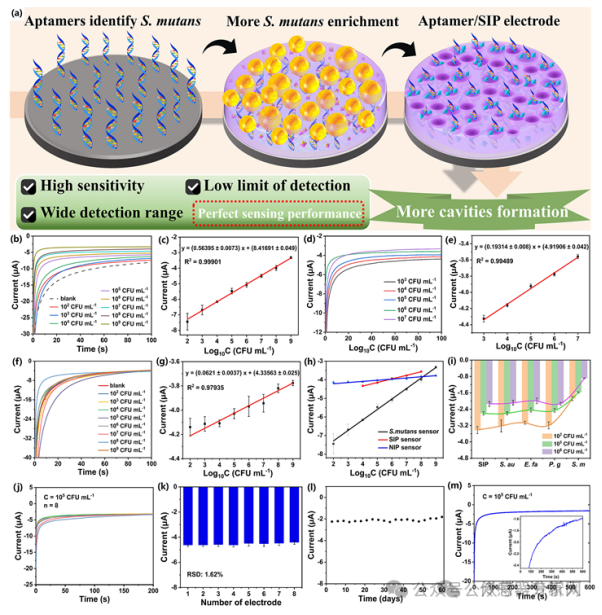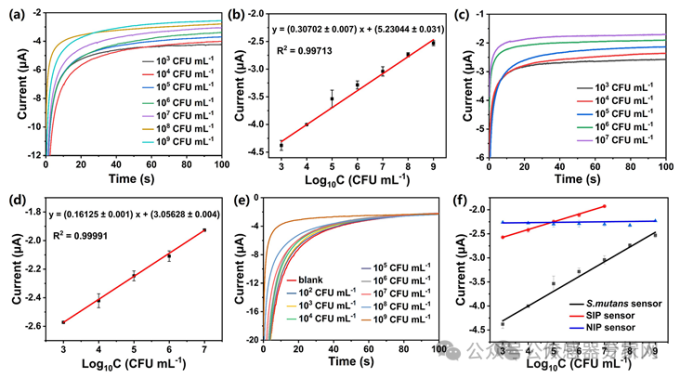The 2022 WHO report states that permanent tooth decay is the most common oral disease, affecting over 2 billion people worldwide. Streptococcus mutans, as the main cariogenic bacterium, its quantity monitoring is of great significance for predicting dental caries. However, traditional bacterial detection methods such as culture medium method, enzyme-linked immunosorbent assay, and polymerase chain reaction technology have drawbacks such as long time consumption, low sensitivity, and expensive instruments.
In recent years, electrochemical sensors have opened up new platforms for bacterial detection due to their advantages such as low cost, short time consumption, high specificity, and fast response. For S mutans, Researchers have developed a series of sensors with antibodies, antimicrobial peptides, vancomycin, and lectins as recognition elements, but poor sensitivity and long-term stability limit the detection application of sensors in real saliva. In addition, there is interference between multiple components in saliva, which makes detection difficult. How to improve selectivity remains a research difficulty in the practical application of portable saliva sensors
Recently, researcher Zhang Qiang of Changchun Institute of Applied Chemistry, Chinese Academy of Sciences, cooperated with Han Guanghong, deputy chief physician of the Stomatological Hospital of Jilin University, to develop a portable saliva sensor based on aptamer/SIP non enzyme dual recognition element, which uses carboxylated multi wall carbon nanotubes (c-MWCNTs) as the base material, methylene blue (MB) as the embedded redox probe, and integrates screen printed electrodes (SPE) (Figure 1).Compared to other S Compared with the mutans sensor, the portable saliva sensor prepared in this study exhibits higher sensitivity (564.0 nA/dec), lower detection limit (LOD, 2.6 CFU/mL), and wider linear detection range (10 ²~10 ⁹ CFU/mL). In addition, the
sensor can detect S. in real saliva samples in situ and real-time mutans, It has shown great potential in clinical caries prediction and early diagnosis.

Firstly, researchers electrodeposited c-MWCNTs onto SPE electrodes using the CA method and investigated the effect of electrodeposition time on electrochemical performance. S. Mutans specific aptamers are modified with an amino group at one end and undergo condensation reaction with carboxyl groups on the c-MWCNTs electrode to form amide bonds, achieving stable covalent bonding. The successful fixation of the adapter was confirmed through XPS analysis and CV characterization.Subsequently, using CV within the potential range of -0.8~+0.9 V, S mutans、 Pyrrole monomer and MB were electrodeposited on aptamer electrode to obtain PPy/S. mutans electrode. The results show that the reduction and oxidation peaks of MB are displayed at -0.28 V and -0.14 V, and the oxidation peak of pyrrole is displayed at 0.9 V. When the number of CV electrodeposition cycles is 15, the electrochemical performance of the electrode is optimal.Through SEM observation, it was found that the surface of PPy/S. mutans electrode was covered with spherical S Mutans (with a bacterial diameter of approximately 0.6~1 μ m) and irregular polypyrrole spheres. The EDS spectrum shows S Mutans have unique Mg and P elements. The above results all prove that S The successful electro polymerization of mutans.Using lysozyme/Triton X-100 to remove S After mutans, the aptamer/SIP electrode is obtained. A significant increase in current was observed in the CV curve, with the MB reduction peak at -0.45 V. Subsequently, the effects of pyrrole concentration, S. mutans polymerization concentration, and eluent type on S. were studied using CA at a potential of -0.45 V The impact of mutans sensors on their electrochemical performance.

To further verify S The successful removal of mutans led researchers to use SEM to characterize the morphology of aptamer/SIP electrodes. It was found that no granular S. was observed in the SEM image mutans。 Subsequently, the electrochemical performance of aptamer/SIP electrodes was studied using CV and EIS. The CV curve of the aptamer/SIP electrode in a 5 mM K æ Fe (CN) ₆ solution was recorded at a scanning rate of 25-200 mV/s.It was found that the intensity of the redox peak was linearly correlated with the square root of the scanning rate, indicating that the electrochemical reaction of the electrode was controlled by the diffusion process. Meanwhile, the EIS results showed that removing S After mutans, Rct decreased from 4911 Ω to 2303 Ω, and the interface resistance significantly decreased. Indicates the removal of low conductivity S After mutans, a large number of electron transfer pathways were created on the electrode surface, significantly improving the electrochemical activity of the electrode.

As shown in Figure 4, the CA method was used to detect artificial saliva containing a concentration range of 10~10 μ CFU/mL S. mutans at a potential of -0.45 V. It was found that the current value varied with S The concentration of mutans decreases linearly with an increase in negative logarithmic values. Compared to other existing S Compared to mutans sensors, this S Mutans sensors have higher sensitivity (564.0 nA/dec) and lower LOD (2.6 CFU/mL).In addition, the linear response range of the sensor (10 ²~10 ⁹ CFU/mL) covers the salivary S. mutans levels under human physiological and dental conditions, allowing for direct detection of actual saliva samples without dilution. To evaluate the detection advantages of dual recognition sensors, a single recognition element SIP sensor without an adapter was prepared.Under the same conditions, the sensitivity of the SIP sensor is 193.1 nA/dec, the detection limit is 7.6 CFU/mL, and it exhibits a narrow linear detection range of 10 ³ to 10 ⁷ CFU/mL. The results indicate that the adapter plays an important role in improving the detection sensitivity of the sensor. In addition, the S. mutans sensor also demonstrated good selectivity and reproducibility, and was able to maintain sensitivity to S. for 60 days Mutans have efficient sensing and excellent long-term stability.

To evaluate S The practical application potential of mutans sensors has been applied by researchers to detect S. in real saliva samples of healthy individuals mutans。 As a result, it was found that with S The concentration of mutans increased from 10 ³ CFU/mL to 10 ⁹ CFU/mL, and the current value varied with S The concentration of mutans decreases linearly with an increase in negative logarithmic values.In real saliva, the sensor exhibits a sensitivity of 307.0 nA/dec and a LOD value of 4.8 CFU/mL, which can detect S The accurate quantification of mutans has practical application potential.

In summary, this study developed a portable biosensor based on dual recognition elements for rapid detection of S. in saliva mutans, This provides potential for early prediction of dental caries. This sensor has excellent sensitivity, high selectivity, and good stability, making it suitable for long-term practical applications.Create S. by fixing the adapter and SIP dual recognition components Mutans specific imprinting cavities and highly selective sensing interfaces. MB is embedded as an oxidation-reduction probe into the SIP network in S Mutans provide direct electrical signals during the reaction to achieve S In situ real-time detection of mutans.In addition, the sensor does not contain any easily inactivating substances such as antibodies or other proteins, eliminating the risk of signal degradation caused by long-term use of the sensor. The successful application of this sensor in real saliva detection highlights its enormous potential in clinical caries prevention and personalized oral health monitoring.



